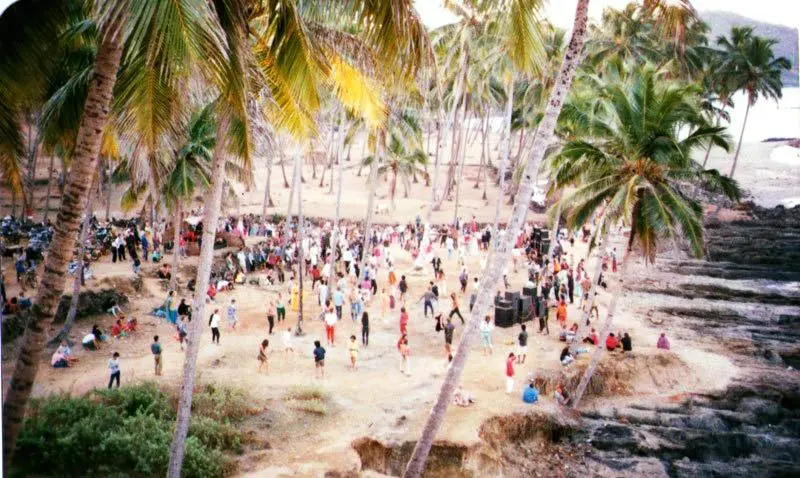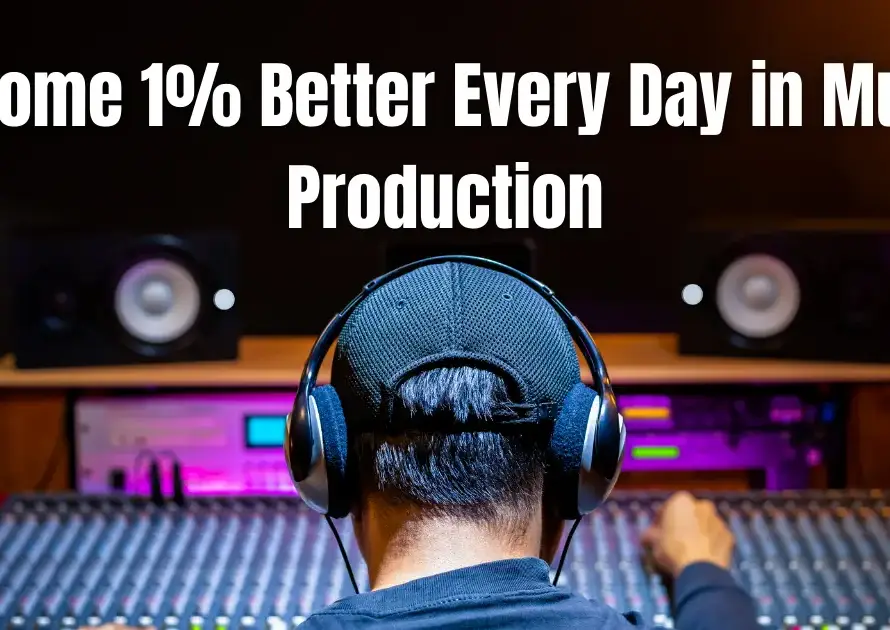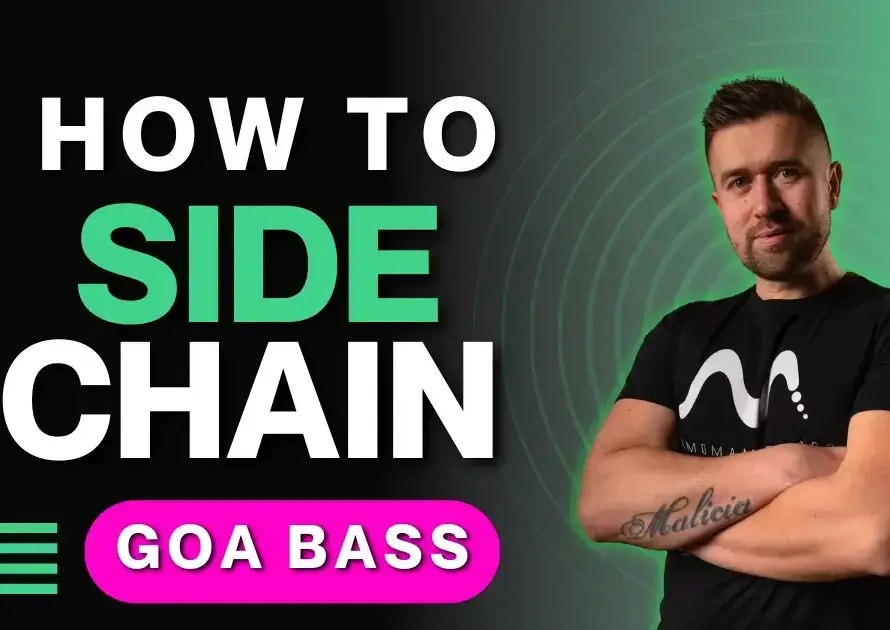Goa Trance vs. Psytrance
Key Points
-
-
Goa Trance at its core can be understood as 4/4 dance music with deep roots in acid (the TB-303), blending strong melodic and harmonic elements that often stray outside standard major/minor tonalities. It relies on varied and precise synthesis, evolving sound design, and creative use of sampled or processed organic elements to tell a sonic story in the listener’s mind.
Repetition plays a central role – developing timbrally or harmonically over long stretches – balanced with moments of novelty that shift direction without breaking the flow. Ultimately, the purpose was (and still is) to induce a trance state on the dancefloor, where dancers can lose themselves completely. At its heart lies an intention of creating something uplifting, mind-expanding, and positive for the world.From a stylistic perspective, Goa is melodic, kaleidoscopic, and story-driven, with modal harmonies (often Phrygian/Phrygian Dominant), long-evolving lead lines, acid arps, and basslines that can be off-beat 1/8 or rolling 1/16. Compared to psytrance, Goa basslines often have a slightly wider stereo presence above the sub, while the true sub remains mono.
Layered melodies are crucial in Goa Trance – often two or three lines intertwine, building a hypnotic atmosphere. Goa also has several substyles such as Oldschool/Retro Goa Trance, Newschool/Neogoa, Nitzhonot (Nitzho Goa), and Suomi (Suomisaundi).Depending on the substyle (full-on, darkpsy, forest, hi-tech, prog), you may sometimes hear melodic ideas borrowed from Goa, but the overall emphasis is on groove and sound design.
Psytrance is more focused on tight groove and hypnotic momentum. It relies on a precise rolling 1/16 bass, ultra-clean transient design, and modern digital timbres (FM, wavetable, advanced modulation).Its structure and arrangement differ from Goa: the main motif is the kick + bass, supported by FX, stabs, and FM leads.
-
-
-
Both styles share psychedelic DNA and often blend on the dancefloor, yet they differ in composition, bass architecture, arrangement density, and mix priorities.
-
Examples :
Typical Goa Trance examples :
Typical Psytrance examples :
Origins & Aesthetics
-
-
Goa Trance emerged in the late ’80s and early ’90s from the acid-party and beach scene in Goa, India. Music circulated on DAT tapes, with DJs handpicking tracks from all over the world – often without the artists even knowing their music was being played there. The unifying factor was never the genre label, but rather whether a track carried that special psychedelic quality that could, in the right context and timing – and often coupled with LSD – create an explosive, transformative experience on the dancefloor.
The early scene was defined by diversity and creativity. Every Goa artist sounded different, using unique sounds, structures, melodies, atmospheres, and vibes. Many even followed a personal rule to never make the same track twice, always seeking to create something fresh from the ground up – starting with the kick and bassline. The focus was on making music as powerful, clear, and emotionally moving as possible, even though limited equipment and technical knowledge often resulted in rougher production quality. Ironically, that rawness is something that some listeners have come to cherish today.
In essence, Goa was less about strict stylistic rules and more about freedom and experimentation. It was a fusion of many influences rather than a box with fixed boundaries. Only later did the music become codified under the terms Goa Trance or Psychedelic Trance, as the scene grew and global recognition expanded. -

Disco Valley, a popular rave venue in Vagator, Goa in 1988. Photo courtesy Ray Castle / I Love Goa. Image taken from https://www.vice.com/
-
-
-
Psytrance consolidated in the late ’90s and early 2000s, absorbing Goa’s psychedelic DNA while moving toward a cleaner, punchier, and more groove-centric sound. It became especially popular in Israel and across Europe, with substyles such as full-on, darkpsy, forest, prog, and hi-tech each emphasizing different rhythmic and timbral ideals.
Today, both Goa and Psytrance often develop within their own established frameworks. Yet, the original spirit of Goa reminds us of something essential: openness, eclectic selection, and a willingness to cross boundaries. Looking both back to those roots and forward to new possibilities may be the key to keeping these styles fresh, creative, and inspiring.
-
Tempo & Energy
-
- Goa Trance: ~135–150 BPM (often around 145 BPM). Energy swells via melodic development and big filter sweeps.
-
- Psytrance: ~138–148 BPM depending on substyle (full‑on often around 142–146). Energy is shaped by groove, drops, fills, and precise kick‑bass interaction rather than long melodic arcs. Darkpsy typically ranges from 145 to 170 BPM. Hi-tech often runs at around 185 BPM. Psycore is highly experimental and can reach up to ~200 BPM.
-
- Psytrance: ~138–148 BPM depending on substyle (full‑on often around 142–146). Energy is shaped by groove, drops, fills, and precise kick‑bass interaction rather than long melodic arcs. Darkpsy typically ranges from 145 to 170 BPM. Hi-tech often runs at around 185 BPM. Psycore is highly experimental and can reach up to ~200 BPM.
-
Sound Design
-
- Goa palette: 303/acid, supersaw-ish leads, analog‑style arps, shimmering pads, spacey FX; often warmer or slightly saturated textures.
-
- Psy palette: Wavetable/FMsynth morphing tones, precise noise bursts, percussive zaps, gated textures, pitch‑mod stabs; overall tighter transients and cleaner low‑end.
Kick & Bass Architecture
-
- Goa: Kicks are punchy but less clinical; bass can be off‑beat/1⁄8 stabs or rolling 1⁄16, usually with slightly longer decays that support the melody. Many new‑school Goa tracks add a little stereo width above ~120 Hz (chorus/ensemble), while keeping the sub region mono.
-
- Psy: Rolling 1/16 bass with very short notes and surgical interaction with a tight, tuned kick. Groove lives in micro‑timing, envelope design, and consistent low‑end amplitude.
Arrangement & Density
-
- Goa: Busy mid‑high content; multi‑layered leads and counter‑melodies. Sections feel like chapters in a journey.
-
- Psy: Streamlined layers with focus on rhythm section and FX transitions. Drops, fills, and turnarounds define structure more than melodic development.
Dancefloor Experience
-
- Goa: Uplifting, euphoric, narrative. Best when the crowd is ready for melodic storytelling.
-
- Psy: Mesmerizing, locked‑in, groove‑first hypnotism. Great for extended, precision‑mixed DJ sets where energy is modulated via rhythm.
Quick Reference Table
| Element | Goa Trance | Psytrance |
|---|---|---|
| Tempo | ~135–150 (often 145) | ~138–148 (style‑dependent) |
| Harmony | Modal, melodic, evolving | Minimal, motif‑driven |
| Bass | Off‑beat/1⁄8 or 1⁄16 rolling (often a bit wider above the sub) | Rolling 1⁄16, very mono and consistent |
| Kick | Punchy, less clinical, often 909 Analog Kick drums | Very tight, tuned, transient‑focused |
| Sound design | 303 acid, arps, analog flavor | FM/wavetable, digital precision |
| Arrangement | Story/journey, dense mids/highs | Groove‑centric, fewer layers |
Suggested Listening, Study & Analyze
-
- Classic Goa: Astral Projection, Man With No Name, Hallucinogen, Etnica/Pleiadians, Green Nuns of the Revolution, Slinky Wizard, Doof, Technossomy, Psychaos, Darshan, Shakta, Process, Tristan, Syb Unity Nettwerk, Chi-A.D., Electric Universe ,The Infinity Project, Space Tribe, and more..
-
- Modern Goa : Filteria, E-Mantra, Mindsphere, Khetzal, Artifact303, Morphic Resonance, Goasia, RA, Afgin, Celestial Intelligence, Triquetra, Merr0w, Psylent Buddhi, Median Project, JaraLuca, Psy-H Project, Centavra Project, Clementz and more…
-
Classic Psytrance (late ’90s / early ’00s): Infected Mushroom (early albums The Gathering, Classical Mushroom), Talamasca, GMS, Astrix (early works), 1200 Micrograms, Bamboo Forest, X-Dream, Cosmosis, Logic Bomb, Electric Universe, Azax Syndrom and more…
-
Modern Psytrance: Vini Vici, Ace Ventura, Symbolic, Outsiders, Ajja, Tristan, Sonic Species, Raja Ram , Burn In Noise, Astrix , Bliss, Ritmo, Zen Mechanics, Vertical Mode, Mad Tribe, Waio and more..
P.S . This blog post was refined with the kind input of Colin Bennun, aka OOOD and Gordon Clone Brown, who contributed their knowledge and first-hand experience to enrich the content.
Playlist of 10 modern Goa Trance producers’ tracks :
Want to learn Goa Trance or Psytrance?
Join my 1-on-1 online lessons. I’ll focus entirely on you and help you start making your own tracks fast.
Why 1-on-1 lessons?
Learning Goa or Psytrance alone can be slow and confusing. In a personal session we focus on your roadblocks—kick & bass, sound design, melodies/scales, arrangement, mixing—and build a repeatable workflow. You’ll leave with clear next steps, track feedback, and resources tailored to your DAW so you can finish music faster and with confidence.
Few testimonials after my 1-on-1 sessions
Lukas Z is an EXCELLENT music teacher! His professionalism and meticulous attention to detail truly EXCEEDED my expectations. Working with him was a breeze thanks to his deep understanding and remarkable cooperation. Great teacher, very professional, and will take you to the NEXT PRODUCTION LEVEL. Highly recommend booking lessons with him! 🎶👏
amc6962
A truly professional and useful experience. Flawless audio quality, and the same goes for the video. This guy is both professional and friendly. I recommend him to all producers looking for techniques and sound design in a very specific style: Goa Trance. Take at least 15 hours of video lessons with him. Bisous
dj_sueur
Lukas is an absolute PRO! He is the perfect teacher, covering many subjects in a short period of time with exceptional clarity and professionalism. 🎶🙌 If you’re looking for a mentor for music production (and specifically for Goa trance), don’t hesitate—book a meeting. You won’t be disappointed!


